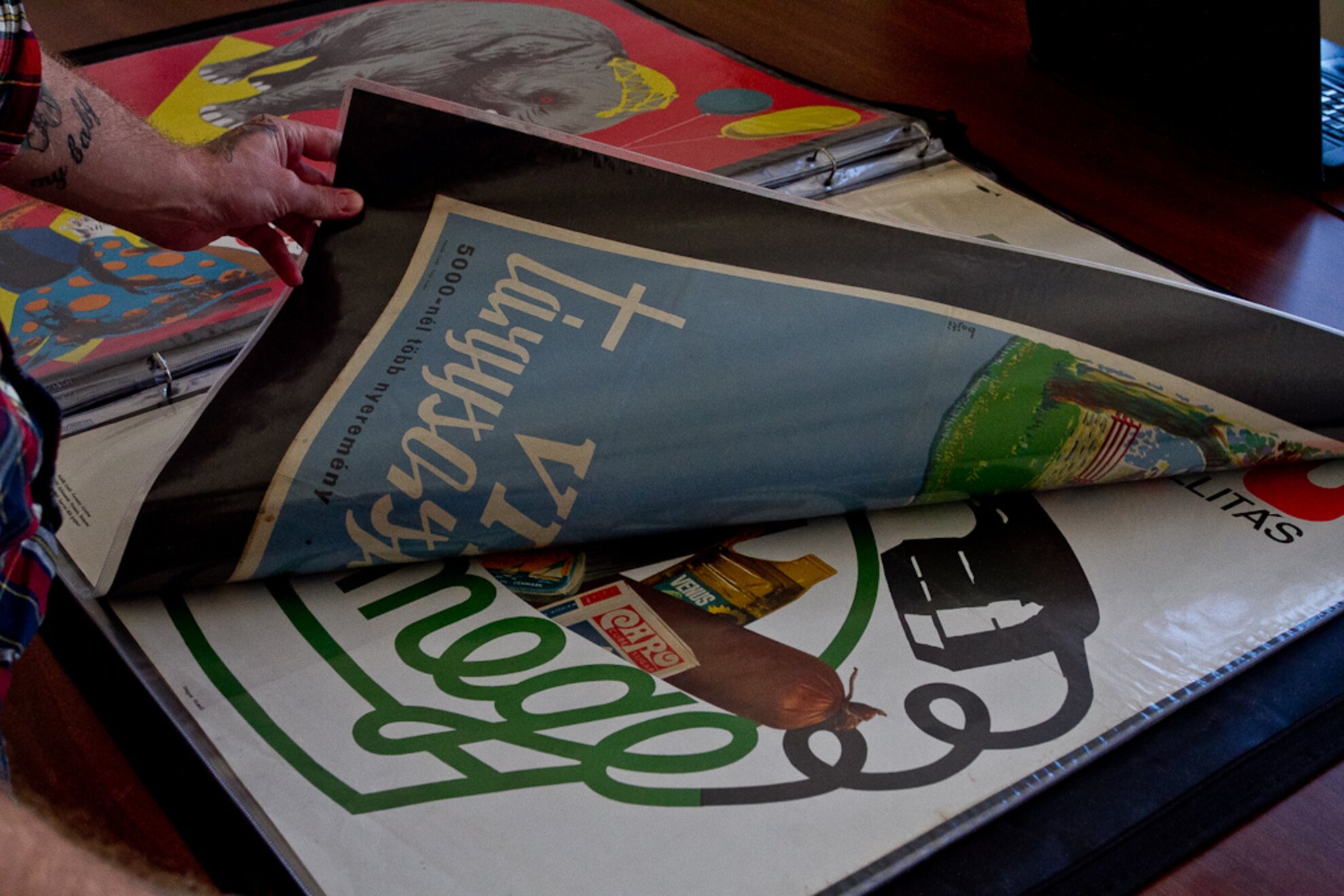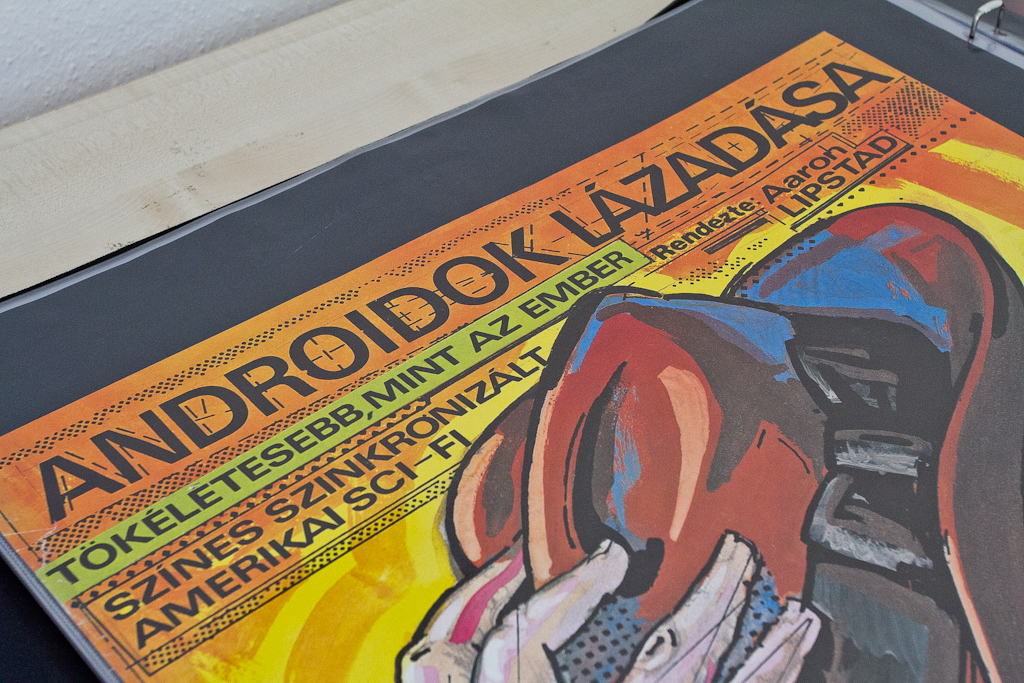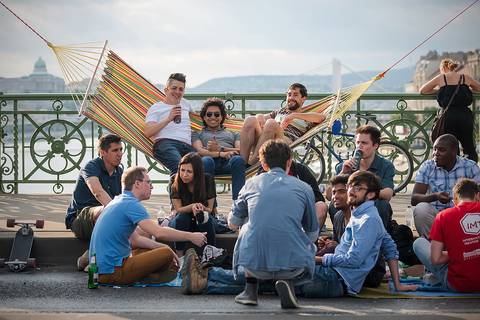There was once a time when streets were not full of the best loan offers of banks or the greatest discounts of fast food chains. In the previous century artistic and sophisticated works advertising legendary theatrical performances or films ruled the surfaces of streets. They were called posters. The newsbringers of the streets were meticulously designed pieces and whether they served as advertisement, propaganda or film posters, they were clear-cut messages to be faced.
It’s good to buy cinemas tickets! Take a look at the summer fashion at the State Store! Be careful between the rails at the railway station!
It’s no surprise we got to thinking whether one can still find original 20th century posters and put them on the living room wall.
And so we sought out Ádám Várkonyi’s Plakátbolt in Galamb utca in the 5th district. The poster-lover boy has always been fond of collecting something. At times he was interested in basketball cards, stickers, cigars, old coins or wines, at other times he piled up stamps. At first, Ádám was like other hobby-collectors, who is in possession of a good number of items but doesn’t think of creating a serious personal collection. Then 4-5 years ago, when he fell in love with his first poster in an auction catalog, everything changed. And when he, for the first time, caught a glimpse of the 1937 poster, he knew this was his calling.

If you don’t look it up, you’d never think that Hungary has had and still has a good number of postermakers (György Kemény, András Máté, Lajos Görög, Árpád Darvas, Sándor Ernyei, István Balogh). The processes involved in postermaking were completely different in the past. A graphic artist brought to life totally autonomous ideas, that weren’t only drawings but works of art, masterpieces. Postermaking has always been connected with waves and styles, it was influenced by constructivism and Art Nouveau, as well.

“The world has changed and with it the methods of postermaking. There was no single method between 1885 and 1985, too, but basically it went like this: the artist and the company ordering the poster agreed upon the message to be conveyed, and then the artist sit down and came up with something as an artist and not as a marketing expert. Today, 25 people sit down, create a concept that suits the whole campaign, pass it all on to the graphic designer, including instructions about what they should do with the colors and other details. And even when the graphic designer is done, there are many modifications and changes. The world has changed, no one would give such liberty to an autonomous person any more.”

This lack of trust is the reason that only so many autonomously created posters exist, exceptions being maybe the flyers and posters of alternative theaters, clubs and pubs (Trafó, Gödör, Sirály, Tűzraktér). (Ádám’s favorite is painter Attila Stark’s poster made for the HANNA-HANNA festival, of which he saved two copies, from the walls of Fogasház and Tűzraktér. He kept one of them, while donating the other to the Magyar Nemzeti Galéria to enrich its collection. Of course, suspicion arises, whether the poster on your living room wall is indeed genuine and not a replica. According to Ádám, years of experience, ample practice and expertise are needed to notice fake pieces.

“If you held thousands of posters in your hands, you recognize the pressing technique. You know which style was employed with posters and you won’t mistake it any more. Yes, you do have to pay the price of learning. I myself have spent a lot of money for something that I thought was a good deal, but then it turned out it was fake.”If an original poster in poor condition turns up, it goes to a restorer. In the United States they aim to restore the poster in a condition as if it was just printed, that is, if a part is missing, they simply repaint it, they deacidify the paper,then rinse it, toget rid of stains and dirt. Contrary to this, in Europe it’s not customary to make a new poster out of an old one. They do make some substitutions but the little marks and shades of time show themselves.

Collecting posters is not a very fashionable habit in Hungary but the question remains if someone falls in love with one of these unique things of the past, will they be able to save enough money to purchase it. The prices in the shop are about 25-30 000 HUF on average but you can find specialties dating from before the war that cost 150 000 - 300 000 HUF. And size doesn’t matter at all, as you can buy large posters for as little as 5000 HUF, and there are smaller ones for much much more. Prices are determined by a number of factors, such as the artist, the quality of the art, rarity, number of copies, date, if it has recently been on an auction and its significance in art history. This latter is justified by the fact that a piece of art can be novel and revolutionary in a given age, as years and decades pass by it could lose its originality, excitement factor and ingenuity. The most important factor in connection with a poster, however, is whether it can solve its role of intermediary, the role a poster is meant for. If a poster is artistic and functional at the same time, the artist made an impeccable job. Furthermore, prices are also shaped by the number of people who actually like the given piece, who regard it attractive. Parallel to this, it’s important to point out that the number of people who’d intend to acquire them is changing at all times. Today, the posters of skiing, golfing and motorsports are more sought after, while 10 years ago it was posters of cigarettes that were utterly popular.

“The oldest poster I sold was an early advertisement of Diana spirit of salt from the 1890s and it brought me about 70 000 HUF. The poster yielding the most money worldwide was the 1927 German poster of the film titled Metropolis for 140 million HUF. Of course, there’s a Hungarian version, too, but it’s impossible to get hold of, because there’s about one of it in the National Széchenyi Library. If an old copy of it turned out from a cellar somewhere, it could easily be sold for 10-20 million HUF.”

More than half of Ádám’s customers are from abroad, who happen upon the shop while browsing the net or by recommendation. Of course, sometimes passers-by pay a visit as well, but this is rather rare and mostly happens in the summer, the tourist peak season. In Western Europe people have more sophisticated culture of objects, so they are more likely to spend money on old pieces. For a real lover of posters, like Ádám, the greatest pleasure is in selling a poster to someone who he knows will appreciate it and take good care of it, whether they are from Hungary or abroad. In this case he can even give a little discount, only to ensure that the valuable retro artifact will end up in the possession of someone who cares.

“Take a look at a Hungarian magazine of interior design and you’ll find the walls are empty. At your friends’ place, the walls are also empty. Many live in plain homes, among white walls. It’s kind of odd that people don’t think of objects as they have values and can be passed on to their grandchildren. It does matter what you surround yourself with, what environment you live your life in, what it is you see day by day, in your apartment, your home.”

So if you feel that your wall is not complete without an original poster of A Friend is a Treasure, The Towering Infernoor the 1956 Hungarian classic Merry-Go-Round, or you simply think some retro socialism or pop art is missing from your life, seek out Plakátbolt, where you won’t only be richer with original posters but you can also learn the stories beyond. If you looking for something unique during your visit, we have collected the best design oriented suvenir shops in the city.




